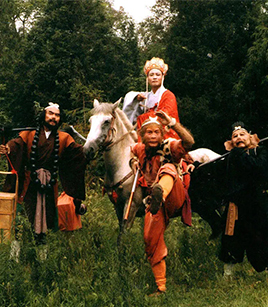‘Journey to the West’

FILE PHOTO: A still from the television series (1986) adapted from Journey to the West
Xi You Ji, or Journey to the West, is a great Chinese novel published during the Ming Dynasty (1368–1644) and attributed to the Chinese writer Wu Cheng’en (c. 1500–1582).
Composed of 100 chapters, the novel is an extended account of the well-known pilgrimage of Xuanzang (602–664), a Tang Dynasty Buddhist monk known for his remarkable contributions to Chinese Buddhism—the travelogue of his journey from Chang’an [in present-day Xi’an, Shaanxi Province], the capital of the Tang Dynasty, to the capital of the ancient kingdom of Magadha [in present-day India] in 629–645, his efforts to learn Sanskrit and Buddhism at the Nalanda monastery and bring over a large number of Buddhist scriptures to China, and his translations of some of those texts.
Xuanzang is referred to as Tang Sanzang in the novel. The novel retains the basic outline of Xuanzang’s own account, but adds elements from folk tales and the author’s invention: Vairocana Buddha gives this task to Tang Sanzang and provides him with three disciples who protect him against evil spirits and monsters during the journey. These disciples are known as the magically gifted Sun Wukong (Monkey King), the slow-witted and lazy Zhu Bajie (Pigsy), and the loyal and obedient Sha Wujing (Sandy), together with a dragon prince who transforms himself into Tang Sanzang’s steed, a white horse. The group of pilgrims head west through eighty-one (here it refers to a large number of) adversities and finally succeed in attaining Buddhist scriptures by the power of cooperation.
In addition to the novel’s comedy and adventure, Journey to the West has been enjoyed for its biting satire of society and bureaucracy and for its presentation of human effort and perseverance. Journey to the West has strong roots in Chinese folk culture, mythology, Daoism, and Buddhism.
In 1986, a Chinese television series adapted from Journey to the West was first broadcast in China. The series became an instant classic in China and was praised for being one of the most original and faithful interpretations.
Edited by REN GUANHONG

 PRINT
PRINT CLOSE
CLOSE